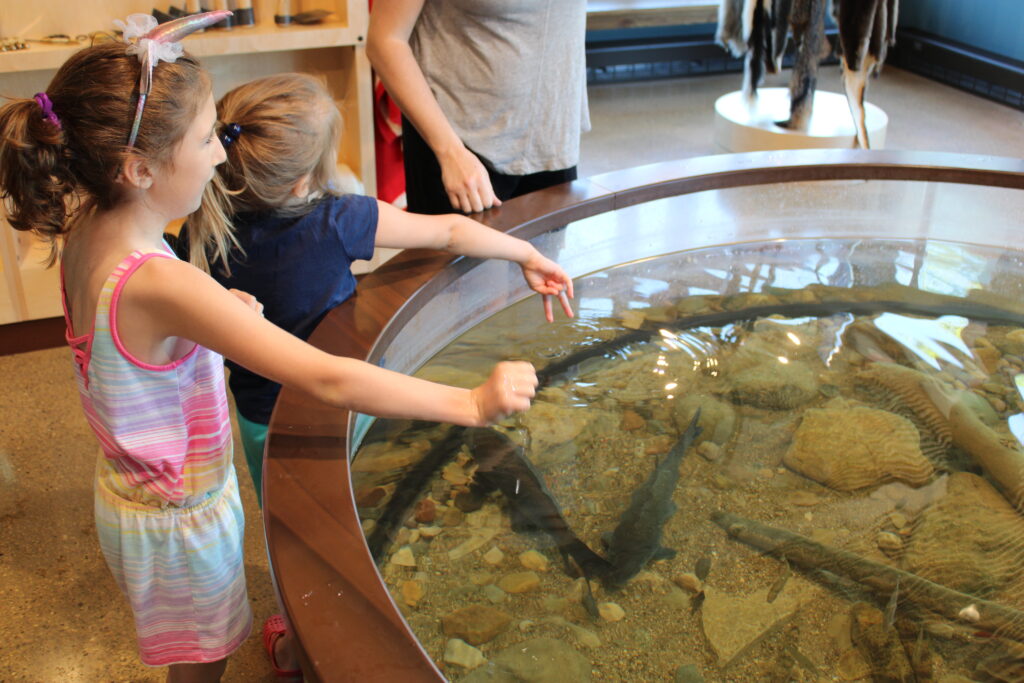By Aaron Rovan
Ohio Humanities Program Officer Aaron Rovan attended the opening of Great Council State Park earlier this month. Below, he reflects on the event—and previews a new Ohio Humanities-funded podcast that shares the stories of Native Ohioans.
On a clear morning in early June, I stood shoulder-to-shoulder in a crowd of hundreds of people in Xenia, a small town near Dayton, to celebrate the opening of Great Council State Park. The new park is situated on the site of Old Chillicothe, a Shawnee village that survived multiple attacks by White settlers. Then, in the early 19th century, the federal government permanently removed the Shawnee people to Oklahoma or other plains states.
Two hundred years later, Glenna J. Wallace, Chief of the Eastern Shawnee Tribe in Oklahoma, traveled from her home in Oklahoma to Ohio, her ancestral homeland, for the park’s dedication.
The ceremony took place in the front parking lot, a large space that was still too small to accommodate everyone. Previous speakers had struggled to make their voices heard—the loudspeakers just weren’t up to the job. There were too many people leaning in to hear, and semi-trucks speeding past on the two-lane road directly behind the audience drowned out many comments.

Chief Wallace surveyed the crowd in front of her, and she was determined to make her voice heard. Working for decades as a university professor had taught her something about public speaking.
“Ohio is our homeland,” she said, her voice projecting over the crowd and road noise. “And we appreciate all the work being done here to educate people about us.
“But remember…” she paused, “Nothing about us, without us.”
The visitors’ center at the new state park is modelled after a Shawnee longhouse, a traditional place of community for the Tribe. Inside, exhibits educate visitors about the history of the Shawnee—what they ate, how they cultivated land, how they built homes. There is even a fish pond where kids (and grownups) can dip their arms up to their elbows and touch the fish.

The second floor brings that history into the present with exhibit panels and interactive pieces that explain the forced removal of the Shawnee, their displacement to Oklahoma and Texas, and the current status of the tribes. Words from the Chiefs of all three federally recognized Shawnee Tribes (the Shawnee, the Eastern Shawnee, and the Absentee Shawnee) are highlighted in panels around a mock bonfire. It’s an example of what can happen when Native Nations are partners throughout the process of museum and exhibit development.
Ohio Humanities’ mission is to share inclusive stories that spark conversation and inspire ideas—especially stories that have been overlooked or undertold.
While earning my PhD from West Virginia University, where I studied English and folklore, I learned about the importance and impact of storytelling. And I’m so proud to work for an organization like Ohio Humanities, where we distribute grants that support storytellers around the state, contribute to projects such as the Lincoln School Story, and advocate for more resources for our partners.
Storytelling is complex, and we know that we will sometimes stumble and fall short of our goals. But all of us at Ohio Humanities are committed to supporting inclusive storytelling—and the collaboration, communication, open-mindedness, and humility necessary to honor impactful stories like those of the Shawnee and Indigenous people everywhere.
Great Council State Park is open now for visitors to learn about Ohio’s Native peoples.
And you can learn about this history in The Ohio Country, a podcast from WYSO Public Radio in Yellow Springs and funded by Ohio Humanities. The Ohio Country shares the perspectives of Native men and women whose ancestors were forced from their Ohio homeland.

In the series, journalists Neenah Ellis and Chris Welter also interview teachers, artists, scholars, historians and others about the lands above the Ohio River known as The Ohio Country.
In the years just before Ohio statehood in 1803, there was cooperation between new settlers and the Indigenous people of Ohio—an exchange of ideas and technology.
But over time, the new settlers wanted more land. Conflict and death followed. Ohio Tribes were pushed onto reservations further and further north in the state. Then, the U.S. government imposed forced removals.
While those Indigenous people have died, their stories have not.
The Ohio Country podcast officially launches on July 2nd. I hope you will listen at WYSO.org or your favorite place for podcasts.
Thank you for supporting Ohio’s stories.

